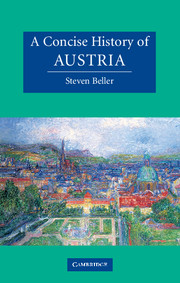Book contents
- Frontmatter
- Contents
- List of illustrations
- List of maps
- Acknowledgements
- Map 1 The Austrian Republic, 2006
- Introduction
- 1 The Eastern March, to 1439
- 2 AEIOU, 1439–1740
- 3 Countering reform, 1740–1866
- 4 Empire on notice, 1866–1918
- 5 The land without qualities, 1918–1945
- 6 Austria Inc., from 1945
- Conclusion
- Guide to further reading
- Index
- CAMBRIDGE CONCISE HISTORIES
5 - The land without qualities, 1918–1945
Published online by Cambridge University Press: 05 June 2014
- Frontmatter
- Contents
- List of illustrations
- List of maps
- Acknowledgements
- Map 1 The Austrian Republic, 2006
- Introduction
- 1 The Eastern March, to 1439
- 2 AEIOU, 1439–1740
- 3 Countering reform, 1740–1866
- 4 Empire on notice, 1866–1918
- 5 The land without qualities, 1918–1945
- 6 Austria Inc., from 1945
- Conclusion
- Guide to further reading
- Index
- CAMBRIDGE CONCISE HISTORIES
Summary
In 1930 Robert Musil published the first volume of The Man without Qualities. The setting of this novel was Vienna in 1913. Its hero, Ulrich, is a man without qualities, or characteristics, because he refuses to be typecast by dysfunctional Habsburg society. Instead he is determined to be his own man, and it can be seen as typically ‘Viennese’ that this turns into an investigation of his sexual and psychological identity. The Man without Qualities is not simply a historical novel about pre-war Vienna; it is also a discussion of Austria (and Germany) during the period in which it was written, the interwar years. It is not only about a man without qualities, but also about the land without qualities, a country in a severe identity crisis – as well as a spiritual, economic and political crisis – that never recovered from the trauma of having had its imperial character stripped from it in 1918.
Austria in 1918 had become a land without qualities against its will. Austrian history from 1918 to 1945 is a history of people struggling, and failing, to resolve the profound issues raised by the Habsburg Monarchy's collapse. This is a story not only of the Republic of Austria failing to create a new ‘Austrian’ identity, but also of the destructive consequences of the political logic that insisted on the ‘nation’ as the primary political unit. ‘Austrians’ so easily became ‘Germans’ in 1938 because they already saw themselves as part of the German nation.
- Type
- Chapter
- Information
- A Concise History of Austria , pp. 197 - 248Publisher: Cambridge University PressPrint publication year: 2007



